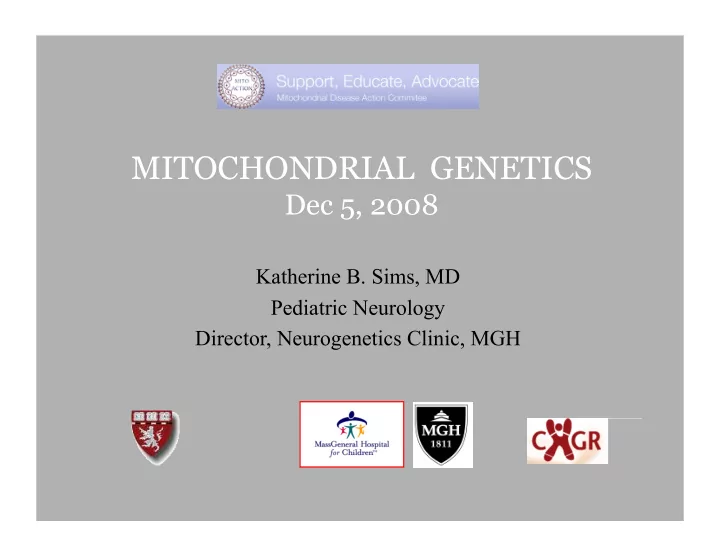

MITOCHONDRIAL GENETICS Dec 5, 2008 Katherine B. Sims, MD Pediatric Neurology Director, Neurogenetics Clinic, MGH
Electron Transport Chain cytosol H+ H+ H+ H+ H+ C I IV III V Q II NADH H+ FADH 2 ADP ATP succinate matrix Electrochemical gradient allows proton flow back into the matrix through Complex V [ATPase] to phosphorylate ADP ATP
Bi-genomic Input nDNA mtDNA
mtDNA genes 13 -ETC structural proteins 22 -tRNAs, 2 -rRNAs
mtDNA deletions – KSS, PEO
mtDNA
Heteroplasmy
Mitochondrial nDNA genes estimated >1200 genes • Structural subunits of ETC complexes • Assembly of ETC complexes • Intergenomic signaling nDNA mtDNA • Mitochondrial assembly & stability • Mitochondrial replication/biogenesis • Fusion Fission • Fatty acid oxidation pathway • Krebs cycle proteins
nDNA genes [Mendelian inheritance] autosomal recessive X-linked autosomal dominant
Mito nDNA genes ETC structural components NDUFV1 Complex I Leukodystrophy, myoclonic epilepsy; LD NDUFV2 Leigh disease NDUFS1 Leigh disease NDUFS2 cardiomyopathy, encephalopathy NDUFS4 FTT, hypotonia, Leigh-like NDUFS6 Leigh disease; adult myopathy NDUFS7 Leigh disease NDUFS8 Leigh disease Flavoprotein Complex II Leigh disease SDHD Hereditary paraganglioma Synthesis of CoQ10 Complex I, II, III Ataxia, myopathy, seizures
Mito nDNA genes Factors of mitochondrial assembly/stability, ox-phos SURF1 COX assembler Leigh syndrome SCO1 COX assembler, Cu +2 Infantile encephalopathy SCO2 COX assembler, Cu +2 Infantile cardiomyopathy COX10 COX assembler Heme A synthesis Infantile encephalopathy ANT1 Nucleotide pool adPEO Thymidine phosphorylase Nucleotide pool MNGIE
Bi-genomic Input nDNA mtDNA maternal mendelian inheritance inheritance
Diagnosis of Mitochondrial Disorder • Clinical multi-system problems • Physiologic abnormalities • Biochemical abnormalities • Pathologic features • ETC dysfunction • Molecular diagnosis mtDNA nDNA
Recommend
More recommend